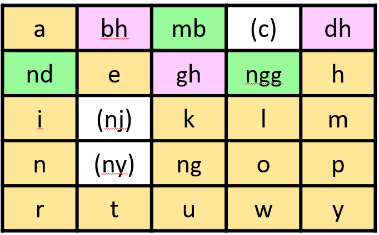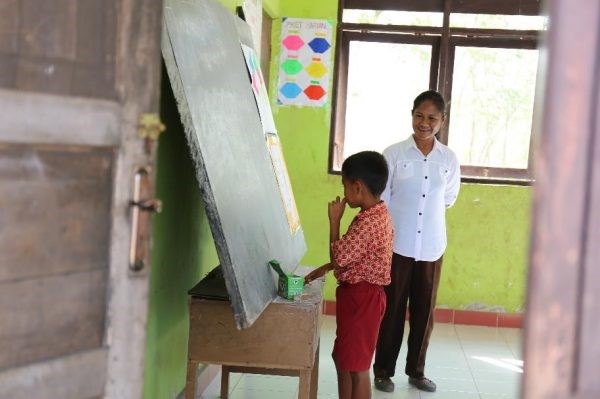with our monthly newsletter.
Indonesia is one of the most linguistically diverse nations in the world with approximately 700 living languages. To promote national unity and identity, the country’s constitution mandates Bahasa Indonesia as the sole language of instruction in formal education. But, over 80% of Indonesia’s population speaks a different language as their mother tongue. In fact, about 221 million children around the world cannot access schooling in their local language.
For these children, a linguistically and culturally inclusive education is crucial.
The Innovation for Indonesia’s School Children (INOVASI) program is piloting different solutions to promote learning in local languages. It’s working to train teachers in appropriate methods for second language acquisition and tackling challenges like creating reading materials for languages that don’t have a standardised alphabet.
Creating Books from Non-Written Languages
Sumba is a remote island in Eastern Indonesia. In the Southwest district of the island, Kodi (pronounced ‘kod-hi’ by native speakers), is actively used by 20,000 speakers and is the second largest ethnic language in Southwest Sumba after Wewewa. It has no written language.
The island’s districts have scored well below the national test average in reading, mathematics, and science. It has a low teaching competency and high prevalence of local languages in homes and communities.
INOVASI partnered with the Summer Institute of Languages (Suluh Insan Lestari, or SIL) to pilot a software that helps makes books. Users can create an original text or select a template, called a ‘shell book’, and insert culturally appropriate pictures and local translations of text. This helps both retain native language preservation while also transitioning to Bahasa Indonesian, following the national language requirements.
This software also helped reach consensus around a Kodi language alphabet, creating a written form for this language. The program was able to create children’s reading books at all levels in the Kodi language, which supports local language learning, provides an essential stepping stone for students, and fosters a culture of reading in the community.
Petrus Lambe, Program Manager of SIL’s Southwest Sumba branch, described why it is important for children to learn the basics of reading in their first language, before transitioning:
“Creative reading in [the] Kodi language can be a bridge for helping children learn Indonesian. Mastery of mother tongue is very important because by mastering the practical concepts in their first language, only 20% of the original effort is needed to master the concepts in the national language.”


Training Teachers
In East Sumba, local language prevalence is equally as strong, but there are written materials already available. INOVASI’s recent baseline study found that 72% of children in East Sumba use a local language, the most common being Kambera (27%) and Bugis (21%).
With the Sulinama Foundation, INOVASI is training teachers in local language-based early-grade reading and writing with child-friendly and levelled books. Local facilitators mentor teachers in partner schools to demonstrate the appropriate use of local language and Bahasa Indonesia as an instructional language, according to the needs of the children.

Early on, teachers faced many issues with the strong prevalence of local language. Ill-equipped with effective strategies and knowledge, they often mixed both the local language and Bahasa Indonesia when teaching, which is an unhelpful strategy for students.
At one remote primary school, SD Wunga, classroom teaching has now improved with the use of better lesson study planning and a transitional teaching model that supports the acquisition of Bahasa Indonesian. In implementing this method, teachers arrange their lesson study plans together in advance, selecting a ‘model teacher’ each week to implement the plan, with other teachers sitting in to observe and watch.
“Students are more comfortable when teachers speak [their] mother tongue in the classroom using the 50:50 strategy – using full mother tongue in the first 35 minutes and using Bahasa Indonesia in the next 35 minutes,” explained Andika Dewantara, an INOVASI district facilitator in East Sumba.
“There are interesting lessons from the process of learning in Grade 2. Now, students experience the learning, there is more intensive interaction and good communication between the teacher and student,” said Naomi Padjadja, an early grade teacher at SD Wunga.
As INOVASI continues this work, we will learn more about what does and doesn’t work to help improve language transition and literacy learning outcomes for Indonesian children in the classroom.
The Innovation for Indonesia’s School Children (INOVASI) program is a partnership between the governments of Australia and Indonesia, managed by Palladium. Working directly with Indonesia’s Ministry of Education and Culture, INOVASI is seeking to understand how student learning outcomes in literacy and numeracy can be improved in diverse primary schools and districts across Indonesia. INOVASI is working in a range of locations across Indonesia, and uses a distinctive locally-focused approach to develop pilot activities and find out what does and doesn’t work to improve student learning outcomes. Learn more about INOVASI at http://www.inovasi.or.id/en/.
Contact: Richard Paulsen
This article originally appeared in DevPolicy and has been republished with permission.
with our monthly newsletter.
